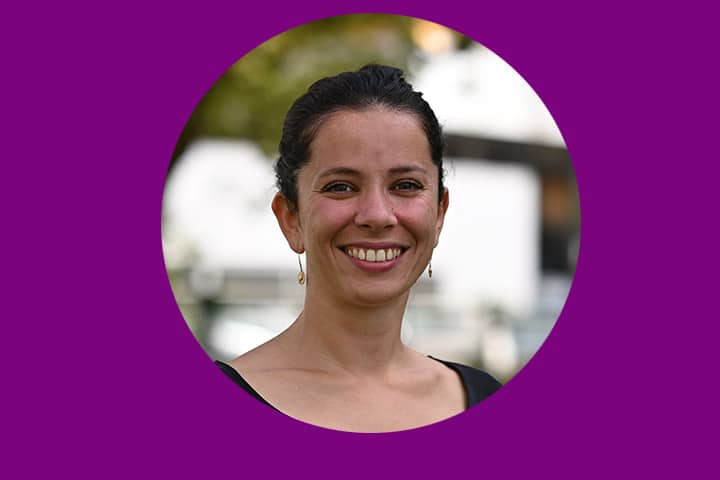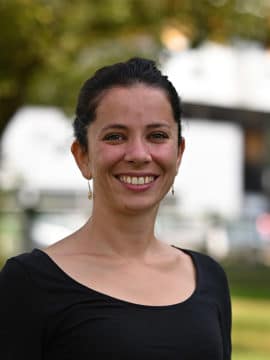
Interview – Camille Jeunet

Camille Jeunet is a CNRS researcher. She joined the INCIA’s MOCOCO team on January 1st, 2021. Interview.
Bordeaux Neurocampus : This is a return to Bordeaux for you. What is your carreer path?
Camille Jeunet : After a degree in MIASHS (mathematics and computer science applied to human and social sciences) at the University of Bordeaux, then a Master’s degree in cognitive sciences (Master’s degree in Bordeaux and Master’s degree in Canada at UQAM in Montreal), I prepared a PhD thesis. It was done in co-direction with Bernard N’Kaoua (HACS laboratory, Bordeaux) for the cognitive science aspect, Fabien Lotte (Inria, Bordeaux) for brain-computer interfaces (BCIs), and Martin Hachet and Sriram Subramanian (University of Sussex, in the United Kingdom) for the haptic aspect. Haptic devices are physical or mechanical tactile-kinesthetic systems, possibly robotic, which can be used to provide feedback during motor learning tasks.
I then did a post-doctorate between Inria in Rennes and the EPFL (École polytechnique fédérale de Lausanne) in Switzerland, during which the objective was to combine neurofeedback, which is a method of self-regulation of brain activity, and virtual reality to improve athletic performance. Finally, I was recruited at the CNRS, first assigned to the CLLE in Toulouse and I joined the INCIA this year.
In short, over the years, I have always had the strange feeling of being considered as a psychologist in a computer science laboratory or as a computer scientist in a psychology laboratory! And today I am very happy to join the INCIA, because it will enable me to strengthen the neuroscientific aspect of my research.
At the heart of this interdisciplinarity, there is one main technology: brain-computer interfaces. What is the purpose of this?
Actually, a person is fitted with an electroencephalographic (EEG) headset and then asked to learn to modulate specific brain activities. This may be to send commands to a machine, for example to enable paralysed people to control a wheelchair or a cursor on a screen without moving. Or it may be to improve or restore cognitive or motor skills. For example, it is possible to design BCI-based training procedures dedicated to stroke patients, as part of their motor rehabilitation to regain mobility of an arm that would be paralysed following the stroke. But it can also be applied to any subject, for example to improve a surgeon’s precision of movement, to improve an athlete’s attention span, etc.
You are part of the Mococo (‘Motor control and cognition’) team led by Arnaud Badets and Thomas Michelet. Can you introduce it to us?
This team is interested in the cognitive processes involved in motor learning, which is a perfect link with my research. It is very interdisciplinary: the team members come from neuroscience, psychology, STAPS and mathematics. So I easily integrated into this team, especially as there is a very good atmosphere!
Many different and complementary methods are used to achieve the same objective. One researcher is interested in psycho-models of motor control, another works a lot on the involvement of the cerebellum, with neuroimaging and functional MRI, a third one uses mathematical and computational models to understand the mechanisms of cognitive and motor learning… Another example: one of us is interested in cortico-subcortical loops in healthy and pathological subjects using transcranial magnetic stimulation (TMS): this is a technique that enables the human brain to be stimulated painlessly by rapidly alternating a magnetic field induced in a copper wire coil placed on the head.
Let’s turn to your research. What will you be working on in this team?
For my part, I mainly work on neurofeedback. Joining the INCIA will allow me to strengthen my research on the understanding of the cognitive and neurophysiological mechanisms involved in learning to voluntarily modulate our brain activity. I will also be able to combine my research using EEG with other methods such as functional MRI, TMS, psychological modeling, computational modeling, for healthy subjects and in the context of different pathologies.
I have three main lines of research. First of all, post-stroke motor rehabilitation: thanks to the “JCJC” (Young researcher) ANR funding that I obtained in 2020, I will be interested in the use of BCIs for motor recovery after a stroke. More specifically, in this project called ABCIS, we are working on the acceptability of BCIs, so that patients and carer-gives will want to use these systems, and thus improve their efficiency.
Secondly, the reduction of motor symptoms in Parkinson’s patients: I am a partner in the BETAPARK collaborative project, financed by the ANR and led by Nathalie George, DR CNRS at the ICM in Paris, whose objective is to design neurofeedback training procedures targeting pathological beta activity.
Finally, I am working on cognitive and motor training of athletes: for example, in football goalkeepers, we tried to find EEG markers that could be targeted in neurofeedback training to improve their attentional abilities. I am also a partner in the BEST-Tennis project led by Benoît Bideau and Caroline Martin (PU and MCF Univ. Rennes 2) financed by the ANR within the framework of the PIA “Very high performance sport”, in which we are working on perceptual and cognitive training for the French tennis team in view of Paris 2024.
You also have a more global project on a European scale with the creation of a consortium.
Our problem is that we are trying to make models to understand neurofeedback learning, the factors influencing it, but there is so much variability and so many mechanisms that we do not know, that our models are often not relevant or reliable, because they rely on small samples of subjects. I am therefore keen to have an ‘open science collaborative’ approach: I have set up a consortium, for the moment European, for which more than 25 laboratories have already expressed interest in contributing. Our idea is to create a training protocol together, over a large number of sessions, this common protocol will be run by each laboratory on a small number of subjects, and the results will serve as a common data base that will be hosted on a CNRS platform and open to all. Each laboratory will run 20 training sessions with 5 people, which already represents 3 to 4 months of full-time experimentation. We therefore hope to go from a dozen participants with 2 to 5 sessions each (which corresponds to standard studies in our field), to between 100 and 200 participants with 20 sessions each: this is a huge step forward that will allow us to better understand human learning, and to design new machine learning approaches!
About Camille Jeunet
Keys publications
- Camille Jeunet, Luca Tonin, Louis Albert, Ricardo Chavarriaga, Benoit Bideau, et al.. Uncovering EEG Correlates of Covert Attention in Soccer Goalkeepers: Towards Innovative Sport Training Procedures. Scientific Reports, Nature Publishing Group, 2020, 10 (1), pp.1705. ⟨1038/s41598-020-58533-2⟩. ⟨hal-02464753⟩
- Camille Jeunet, Bertrand Glize, Aileen Mcgonigal, Jean-Marie Batail, Jean-Arthur Micoulaud-Franchi. Using EEG-based brain computer interface and neurofeedback targeting sensorimotor rhythms to improve motor skills: Theoretical background, applications and prospects.Neurophysiologie Clinique/Clinical Neurophysiology, Elsevier Masson, 2019, 49 (2), pp.125-136. ⟨1016/j.neucli.2018.10.068⟩. ⟨hal-01919018⟩
- Fabien Lotte, Camille Jeunet, Ricardo Chavarriaga, Laurent Bougrain, Dave Thompson, et al.. Turning negative into positives! Exploiting “negative” results in Brain-Machine Interface (BMI) research. Brain-Computer Interfaces, Taylor & Francis, 2019. ⟨hal-02375400⟩
- Camille Jeunet, Fabien Lotte, Jean-Marie Batail, Pierre Philip, Jean-Arthur Micoulaud-Franchi. Using recent BCI literature to deepen our understanding of clinical neurofeedback: A short review. Neuroscience, Elsevier – International Brain Research Organization, 2018, 378, pp.225-233. ⟨1016/j.neuroscience.2018.03.013⟩. ⟨hal-01728767⟩
- Camille Jeunet, Louis Albert, Ferran Argelaguet Sanz, Anatole Lécuyer. ” Do you feel in control? ” : Towards Novel Approaches to Characterise, Manipulate and Measure the Sense of Agency in Virtual Environments. IEEE Transactions on Visualization and Computer Graphics, Institute of Electrical and Electronics Engineers, 2018, 24 (4), pp.1486-1495. ⟨1109/TVCG.2018.2794598⟩. ⟨hal-01679143v2⟩
- Camille Jeunet, Emilie Jahanpour, Fabien Lotte. Why Standard Brain-Computer Interface (BCI) Training Protocols Should be Changed: An Experimental Study. Journal of Neural Engineering, IOP Publishing, 2016. ⟨hal-01302154⟩
- Camille Jeunet, Bernard N’Kaoua, Fabien Lotte. Advances in User-Training for Mental-Imagery Based BCI Control: Psychological and Cognitive Factors and their Neural Correlates. Progress in brain research, Elsevier, 2016. ⟨hal-01302138v2⟩
Website
https://camillejeunet.fr/publications/
About her team
https://www.bordeaux-neurocampus.fr/en/team/motor-control-and-cognition/
Last update 02/09/21
